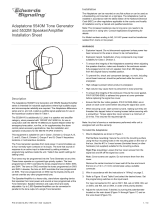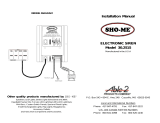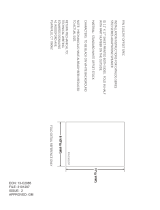
Description and Operation
Edwards Hazardous Location Use Adaptatone is a heavy-duty,
stand-alone audible signaling device intended for industrial appli-
cations where high audible output, safety in a hazardous location
and microcomputer reliability are required. The Adaptatones are
listed for installation in the following hazardous locations:
The Adaptatone operates from local power. Each unit accommo-
dates two different inputs that will sound selected tones. Tone
descriptions are listed in Table 1. Tones are programmed by set-
ting miniature switches within the unit. Settings for all tones are
listed on the inside of the Adaptatone housing cap.
Speaker direction and output level are easily adjustable.
Mechanical Specifications
Weight ....................................................................... 18.4 Pounds (8.4 kg)
Variable Ambient Temp. ............................... 32F to 104F (0C to 40C)
Electrical Specifications
INPUT POWER
Catalog Typical Current (A)
Number Voltage Standby Tone On
5533M-AQ 24V DC 0.061 0.47
24V AC 50/60 Hz 0.25 0.950
5533M-Y6 125V DC 0.31 0.13
250V DC 0.019 0.07
120V AC 50/60 Hz 0.088 0.260
240V AC 50/60 Hz 0.088 0.260
Installation
Installation is to be in accordance with the latest edition of the
National Electrical Code or the Canadian Electrical Code, as appli-
cable, and in accordance with the authorities having jurisdiction.
1. Mount Adaptatone to any solid surface using its mounting
bracket and (3) bolts (not supplied) (Figure 1).
Figure 1. Dimensions
Catalog
Series Class Zones Divisions Groups
5533M I 1 and 2 B, C and D
I 1 and 2 IIA and IIB
2. Open Adaptatone by removing the (8) nuts and bolts and lifting
off housing cover. Keep mating surfaces of housing clean and
undamaged for proper reassembly.
3. Set miniature programming switches on the printed circuit
board (Figure 2) for the desired tone. Set priority tone on SW1
and a secondary tone on SW2. Refer to tone program chart
on inside cover and Table 1.
4. Check Adaptatone label for proper operating voltage. Install
power source and initiating circuit wires through a 1/2" (13
mm) conduit attached to an outlet box and nipple.
The outlet box, conduit and nipple must be suitable for the
hazardous location with 1/2" (13 mm) -14 NPT threading at
conduit openings. Outlet box, conduit and nipple are not
supplied.
Installation Instructions for Hazardous Location Use Adaptatone
Signal Catalog Series 5533M
WARNING
Keep mating surfaces of housing clean and
undamaged to maintain the integrity of the
Hazardous Location construction.
CAUTION
During installation, take care not to damage
components on the printed circuit board.
P/N 3100794 ISSUE 1 © 2005
Cheshire, CT 06410
(P) 800-336-4206 (F) 800-454-2363

2
Connect green ground wire to earth ground.
Connect external wires to Adaptatone wires as shown in
Figure 4. Polarity must be observed for DC applications.
5. Secure outlet box cover.
6. The sound level is factory set to maximum. Adjust volume
level, if desired, by turning potentiometer R72 (Figure 2).
7. Adjust speaker direction by loosening (2) nuts and pivoting
speaker to desired position (Figure 3). Tighten (2) nuts.
8. Ensure mating surfaces are clean and undamaged. Secure
housing cover aligning the straight edge of the cover with the
straight edge of the housing. Torque nuts evenly in opposing
pairs to 140 to 150 in-lb. Apply power.
9. Verify operability.
Maintenance and Test
Examine the unit semi-annually for external accumulation of dirt.
Clean if necessary.
Figure 2. Adaptatone PC Board and Mounting Holes,
5533M-AQ Model Shown
5"
(127 mm)
2-1/2"
(63 mm)
(3) MOUNTING
HOLES
(2) NUTS,
LOOSEN TO
ADJUST
SPEAKER
DIRECTION
R72, TURN
TO ADJUST
SOUND LEVEL
INCREASE
DECREASE
HOUSING COVER
(8) NUTS
(8) BOLTS
NOTE: FOR CLARITY, ONLY SELECTED COMPONENTS ARE SHOWN.
SPKR (+)
SPKR (-)
654321
ON
654321
ON
654321
ON
DETAIL A
PROGRAMMING
SWITCHES
(SEE DETAIL A)
TB1
TB2
SW2
SW1
Figure 3. Speaker Adjustment
HORN PIVOTS 180°
(2) NUTS, LOOSEN TO ADJUST
SPEAKER DIRECTION
WARNING
Do not apply power to the unit until installation is
completed and housing cover and outlet box cover are
secured.
Remove cover from outlet box. Feed five numbered wires
through a 1/2" (13 mm)-14 NPT nipple (not supplied) into the
outlet box. Secure outlet box to Adaptatone.
WARNING
Do not apply power to the unit until installation is
completed and housing cover and outlet box cover are
secured.
The Adaptatone should be tested annually or as required by the
local authority having jurisdiction to ensure continuous service.

3
Installation and Operation
Cat. Series 5533M
Figure 3. Wiring Diagram
*The conduit outlet box, conduit, and nipple must be suitable for the hazardous location application.

4
Figure 15. Tone Programming
Ding Dong
01
02
03
04
05
06
07
08
09
0A
0B
0C
0D
0E
0F
10
11
12
13
14
15
16
17
18
19
1A
1B
1C
1D
25
26
27
28
29
2A
2B
2C
2D
2E
2F
30
31
32
33
34
35
36
37
38
39
3A
3B
24
1E
1F
20
21
22
23
Warble
Siren
Stutter
Slow Whoop
Beep
Chime 1
Fast Whoop
Hi/Lo
Rapid Siren
Yeow
Horn
Air Horn
Dual Tone
Chime 2
Westminster
Three Blind Mice
Phasor
Telephone
Staircase
3 Tone Alert
RESERVED
RESERVED
RESERVED
RESERVED
RESERVED
Telephone 2
Buzzer
Genesis Horn Cont.
Genesis Horn Temp.
Warning 1
Warning 2
Warning 2 Beep
Caution
Multi-tone
Attention
High Freq. Steady Alert
High Freq. Fast Siren
High Freq. Slow Siren
DIN PFEER
NFS 32 001
Ode to Joy
Twinkle Little Star
Dueling Banjos
La Cucaracha
Yellow Rose of Texas
*3 Pulse Tones are for Evacuation Use Only.
Closed / On Switch =
Open / Off Switch =
SWITCH POSITIONS 6 5 4 3 2 1 DESCRIPTION HEX
6 5 4 3 2 1
NFPA Whoop
3 Pulse Horn*
3 Pulse Air Horn*
3 Pulse Dual Tone*
3 Pulse Chime 2*
European Police
European Fire
European Slow Whoop
European General
European Toxic
European Police 2
European Stutter
European Sweep
Percussive pairs of 700 and 570 Hz tones each damped to zero
575 and 770 Hz alternately, 87 ms each
600-1250 Hz up and down sweep in 8 seconds and repeat
Percussive 470 Hz, 83 ms on, 109 ms off
600-1250 Hz upward sweep in 4 seconds and repeat
470 Hz, 0.55 seconds on, 0.55 seconds off
700 Hz percussive repeat at 1 Hz
600-1250 Hz upward sweep in 1 second and repeat
780 to 600 Hz alternately, 0.52 seconds each
600-1250 Hz up and down sweep in 0.25 seconds and repeat
1250 - 600 Hz downward sweep in 1.6 seconds and repeat
470 Hz continuous
370 Hz continuous
450 - 500 Hz, 0.4 to 0.5 second cycle
575 Hz percussive repeat at 1 Hz
Two measures: 411 Hz, 520 Hz, 407 Hz, 312 Hz
Four measures: 787 Hz, 714 Hz, 625 Hz, 952 Hz, 333 Hz
416 - 625 Hz up and down sweep in 13 ms and repeat
570 and 770 Hz alternately, 50 ms each for 1.2s, 1.5 s delay and repeat
440 - 2000 Hz up and down steps, 750 ms delay and repeat
463, 641 and 896 Hz, 200 ms each 1 second delay and repeat
RESERVED
RESERVED
RESERVED
RESERVED
RESERVED
Alternate tones at 567 Hz and 326 Hz, for 0.052 seconds each
1315 Hz to 746 Hz alternating for 0.003 seconds each
Continuous Genesis horn
Temporal Genesis horn
1207 Hz and 493 Hz, alternately 0.002 seconds each
2336 Hz and 493 Hz, alternately 0.005 seconds each
0.500s of 2336 Hz and 493 Hz each alternating for 0.005s followed by 1s delay
453 Hz for 0.040s, 235 Hz for 0.020s, 235 Hz for 0.160s, 260 Hz for 0.050s,
260 Hz for 0.1009s, 235 Hz for 0.050s
376, 357, 352, 382, 355, 375, 384, 375 and 364 Hz alternately on for 0.050s
2232, 4545, 3704, 2777, 4347, 3704, 2500 Hz alternately on for 0.003s
2500 Hz continuous
2500 to 3048 Hz up and down sweep in 0.130 seconds
2500 to 3048 Hz up and down sweep in 0.500 seconds
Ramp downward from 1336 Hz to 522 Hz in 1.2 seconds and repeat
584 Hz for 0.100 seconds and 461 Hz for 0.400 seconds
6.45 seconds of melody followed by 1 second delay and repeat
13.2 seconds of melody followed by 1 second delay and repeat
10.84 seconds of melody followed by 1 second delay and repeat
7.10 seconds of melody followed by 1 second delay and repeat
19.34 seconds of melody followed by 1 second delay and repeat
Three 422 - 775 Hz upward sweeps, 850 ms each, 1s delay and repeat
470 Hz, 3 0.5s pulses separated by 0.5s followed by 1.5s delay and repeat
370 Hz, 3 0.5s pulses separated by 0.5s followed by 1.5s delay and repeat
450 - 500 Hz, 0.4 to 0.5s cycle, 3 0.5s pulses separated by 0.5s followed by
1.5s delay and repeat
575 Hz, 3 0.5s pulses separated by 0.5s followed by 1.5s delay and repeat
969 Hz and 800 Hz alternately 0.250 seconds each
982 Hz and 864 Hz downward sweep in 0.134 seconds
658 Hz to 1312 Hz upward sweep in 3s followed by 0.5s delay and repeat
1087 Hz for 0.5 seconds followed by 0.5 second delay and repeat
982 Hz continuous
554 Hz and 440 Hz alternately 0.800 seconds each
3876 Hz for 0.146 seconds followed by 0.102 seconds delay and repeat
1315 Hz to 413 Hz downward sweep in 1.17 seconds and repeat
No Tone 00
CAUTION
The use of evacuation signals on this product, that is
not specifically Listed for Fire Alarm Use, is subject to
the approval of the Authority Having Jurisdiction.
/



